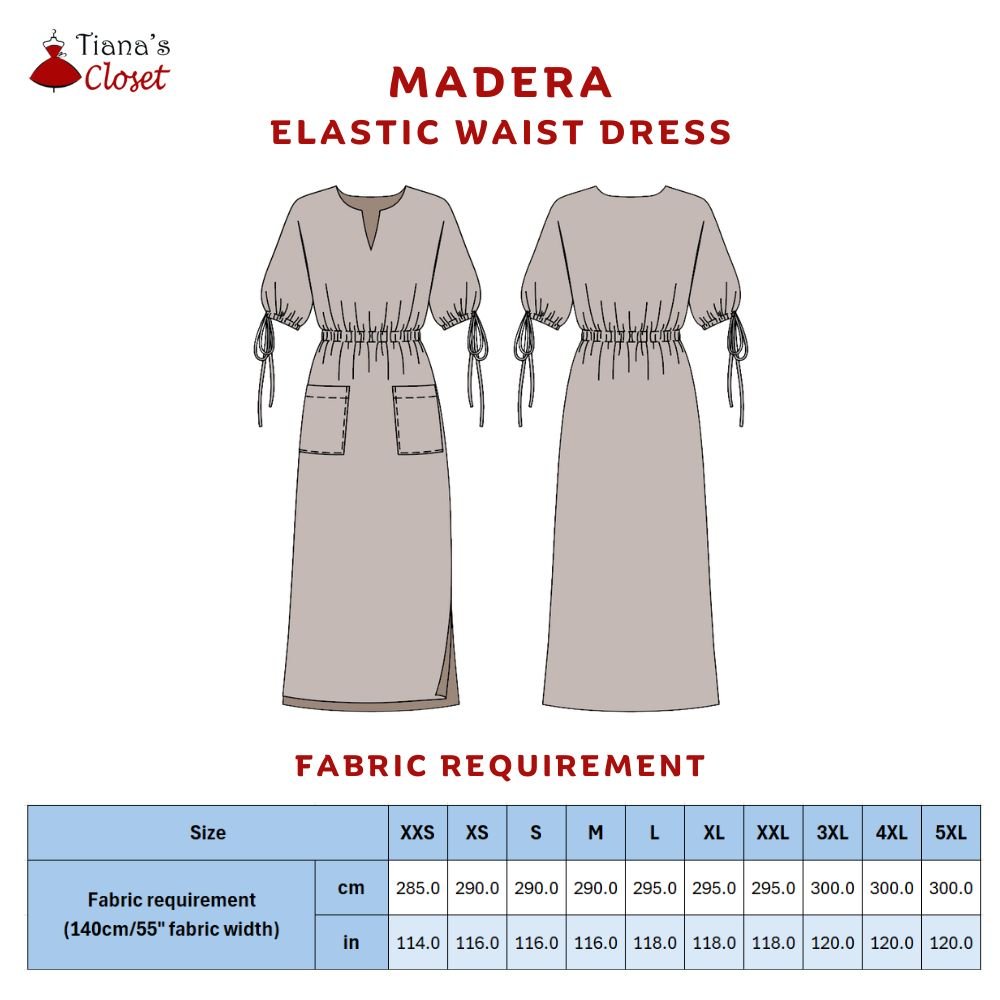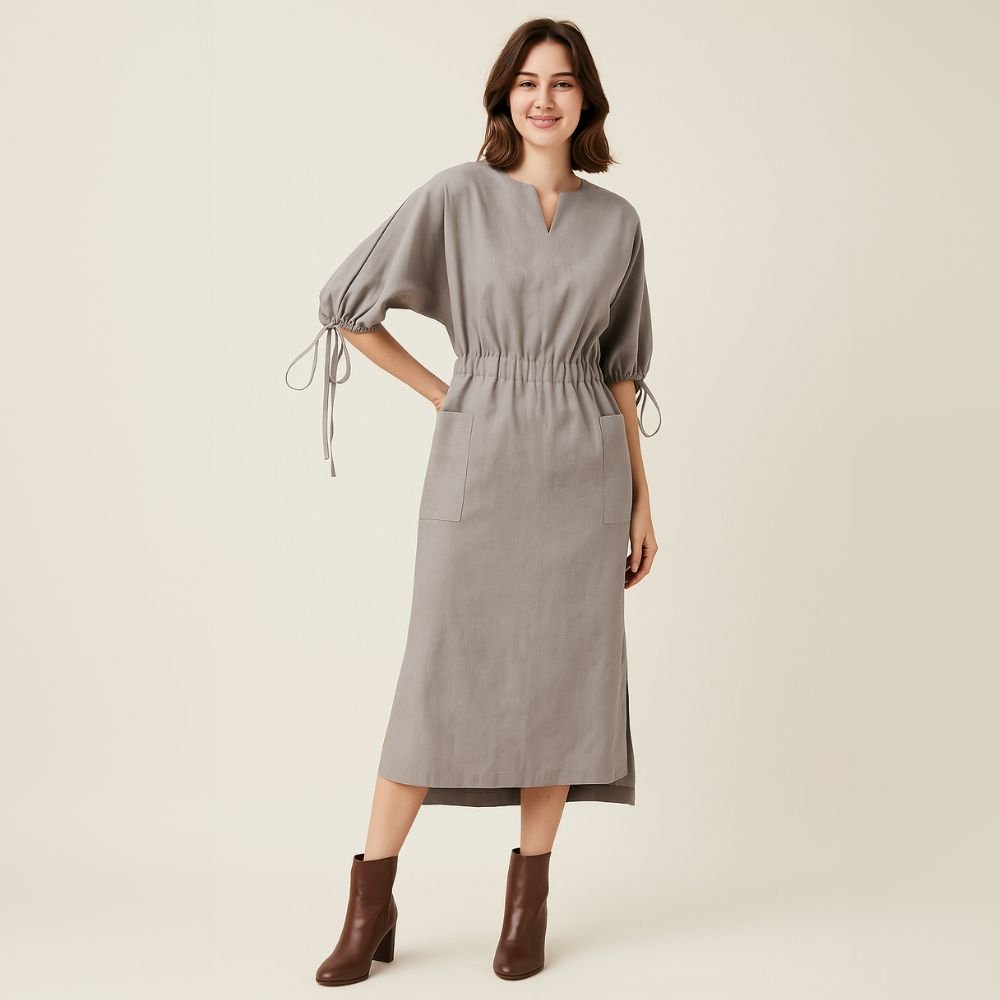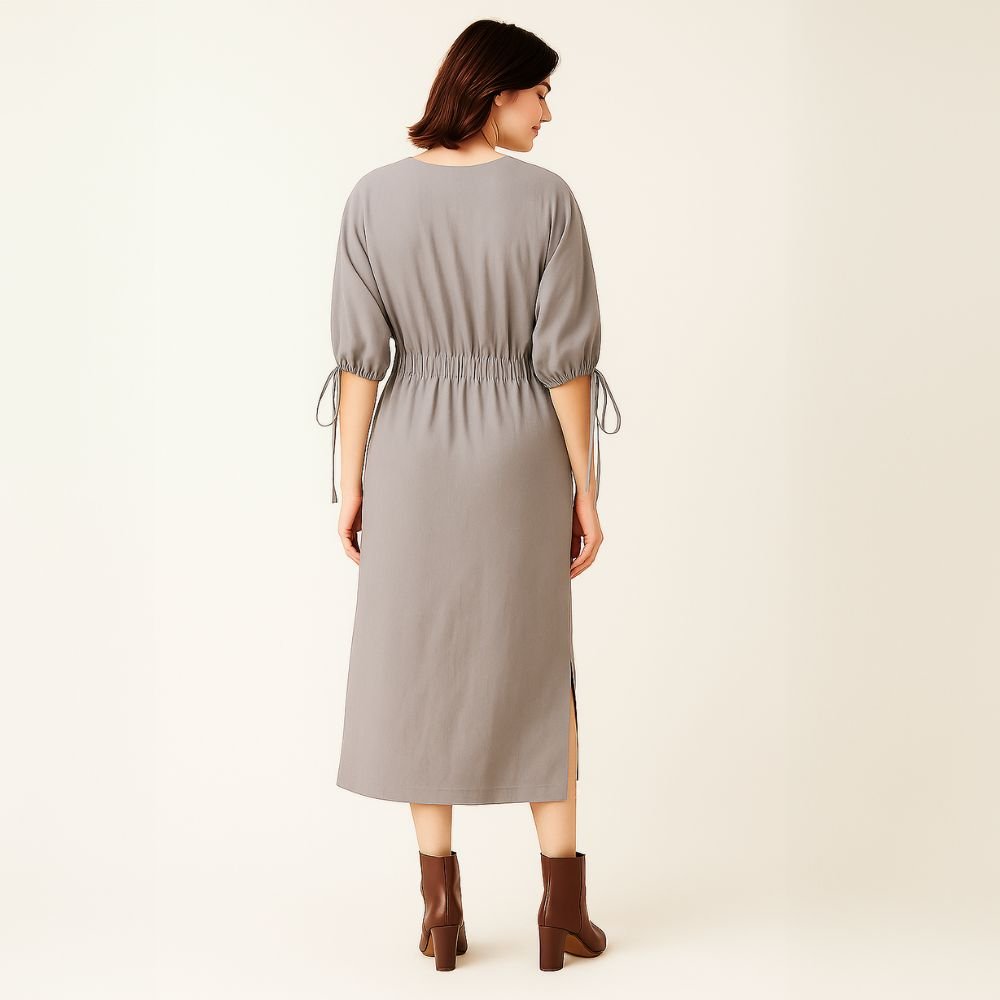Introducing the Madera dolman sleeve elasticated waist midi dress sewing pattern.
This design offers a relaxed fit, dolman sleeves with drawstring detail, an elasticated waist for a flattering shape, plus a side slit and high-low hem for easy movement. Suitable for light to medium weight wovens, it’s a versatile addition to any transitional wardrobe.
This design is suitable for individuals with varying sewing experience, from beginners to advanced makers. It is a straightforward project that can be included in your wardrobe plans.
Let’s have a look at the design:


The front hem is 4cm (1 5/8″ shorter than the back hem.

This pattern is available in ten different sizes, ranging from XXS up to 5XL. Be sure to consult the measurement table to select the size that suits you best. Size guide can be found in the pattern, or here: SIZE GUIDE.
The pattern is provided as a layered PDF; please verify your required size prior to printing to avoid unnecessary paper usage. A detailed first page outlining sizing and printing instructions is included, so it is recommended to review this information thoroughly to confirm your selection. If you require further guidance on printing a layered PDF, please refer to the printing instructions provided in this post: PRINTING GUIDE.
My patterns are available in Projector files, A4/Letter, and A0 formats for easy printing at home or any print shop. You can use either A4 or Letter paper, as the printing area suits both. Always print the first page and check the test square to ensure correct scaling before printing the full pattern to avoid wasting resources.
Some PCs, including my HP laptop, may not print true to size even at 100% scale; I need to set mine to 103%. Check your computer’s settings and adjust the scale as needed. A reader advised printing the PDF as an image to fix scaling issues, though I haven’t personally tested this method.
SEWING INSTRUCTION
TOOLS AND MATERIAL
- Fabric of your choice. This pattern is intended for WOVEN fabric.
- Some elastic for waistband. Recommended elastic width 3.5cm (1 3/8”).
- Some lightweight fusible interfacing for neckline finish.
- Scissors, pencil or fabric marker, ruler, pins
- Sewing machine/Serger or needle and thread
- Printed pattern
FABRIC REQUIREMENTS
Because most fabric will shrink after the first time washing and ironing, it is necessary to pre-wash your fabric. This does not only stop future shrinkage but also removes excess dyes and chemicals from the production process.
The fabric estimation is for pre-washed, pre-shrunk fabric. You may need to account for the shrinkage when using fabric that is not prepared.

If you choose to use fabric of different widths, color blocking, or mixed media, the amount of fabric needed will vary. It will depend on the selected pattern size, the width, and design of the fabric you plan to use. If you want to be sure, print all the paper patterns and lay them out at the width of fabric you plan to use. Measure how much fabric you will need. Don’t forget to account for pieces that need to be cut multiple times and pieces that are cut on the fold.
PATTERN PIECES
The pattern pieces are as follows:
- Front Dress: cut 1 piece on the fold
- Back Dress: cut 1 piece on the fold
- Front Facing: cut 1 piece from main fabric + 1 piece from fusible interfacing
- Back Facing: cut 1 piece from main fabric + 1 piece from fusible interfacing
- Elastic Casing Strip: cut 1 piece
- Drawstring: cut 2 pieces on bias
SEAM ALLOWANCE
– Hem: 4cm (1 5/8”)
– All other seams: 1cm (3/8”)
– Seam allowance has been included in the pattern pieces. Cut pattern as is and use the above-mentioned seam allowance when constructing the garment.
CUTTING INSTRUCTION
Place the pattern pieces on the fabric, pin the pattern pieces to the fabric to secure them in place. Using sharp scissors, carefully cut out the fabric pieces along the outer lines of the pattern. Take your time to ensure precise and clean cuts, as this will affect the fit and overall appearance of your garment.
Make sure to mark all notches and other design features such as darts, pleats, draw marks etc. from the pattern pieces onto your fabric. When sewing the garment, pay attention to notches, they must match up.
SEWING INSTRUCTION
1. Preparation
– Neaten edges of fabric pieces to prevent unwanted unraveling.
– Transfer the elastic casing marking on the WRONG side of the Front Dress and Back Dress pieces.
– Apply fusible interfacing on the neck facing pieces. Transfer the front V stitching line onto the WRONG side of the Front Facing and RIGHT side of the Front Dress, using erasable marker/tailor chalk.
– Transfer the patch pocket placement marking onto the RIGHT side of the Front Dress.
2. Stitch ONE side seam
– Place the Front Dress and Back Dress right sides together, matching the side seam and stitch. The stitching goes from the sleeve towards the hem, and stops at 1cm (3/8”) below the point where the seam allowances extend. Backstitch at both ends of stitching lines to reinforce the seam.
– Press seam allowances open.
– At the unstitched segment near the hem, fold the extended seam allowances twice to the wrong side of fabric, each fold 1cm (3/8”) so that the raw edge of fabric is completely hidden.
– Topstitch along the folded edge to finish the split hem.
3. Stitch the elastic waist
– Fold 1cm (3/8”) of the long edges of the Elastic Casing Strip to the wrong side of fabric and press.
– Place the Elastic Casing on the wrong side of the garment, right side facing up, matching the edges of the Elastic Casing with the elastic casing placement line. Pin to secure.
– Topstitch along the edges of the Elastic Casing Strip to create a channel to insert elastic.
– Cut elastic to desired length and insert it into the channel you just created. Baste two ends of the elastic to the side seams of the garment.
4. Stitch the remaining side seam
– Match the front and back of the garment right sides together, lining up the ends of the elastic casing and side seams.
– Stitch the remaining side seam just like you did in step 2. The stitching must also catch the ends of elastic.
5. Stitch the shoulder seam
– Match up the shoulders of the garment right sides together and stitch. The stitching goes from the neckline towards the sleeve bottom and stops at the notch near the sleeve bottom.
– Press the seam allowances open and topstitch the little split on the sleeve seam.
– Fold the 1cm (3/8”) seam allowances of the sleeve bottom to the wrong side of fabric and topstitch to create a “channel” for drawstring.
– Fold the drawstring in half lengthwise and press to create a crease. Open the drawstring and fold the sides towards the center crease and press again. Then fold the edges of the fabric together and topstitch to create the drawstring.
– Insert the drawstring into the casing at the sleeve bottom. You can now pull the drawstring to gather the sleeve bottom and tie it.
6. Sew the neck facing
– Place Front Facing and Back Facing right sides together and stitch the shoulder seams. Press seam allowances open.
– Place the neck facing and main garment right sides together, matching the neckline, shoulder seams and the front V stitching marking.
– Stitch the neckline using a 1cm (3/8”) seam allowance, at the front V point, follow the marking to stitch the V shape. Reduce stitch length and pivot fabric at each turning point for sharp corner finish.
– Trim seam allowances down to 0.5cm (1/4”) and understitch to the neck facing.
– Turn the facing to the wrong side of the garment, use a blunt pointy object to push the corners. Tack the seam allowance of the facing to the seam allowance of the garment at the shoulder seams to secure the facing in place.
7. Finish hem
– Fold the 4cm (1 5/8”) hem allowance to the wrong side of fabric and topstitch to finish hem.
You can download the free sewing pattern from here:
https://tianascloset.com/index.php/product/madera-dolman-sleeve-elasticated-waist-dress/
Happy sewing! And don’t forget to share your project on my Facebook page: Tiana’s Closet Sewing Patterns or tag me on Instagram #tianasclosetsewingpatterns, I will be thrilled to see the garment in real life!
